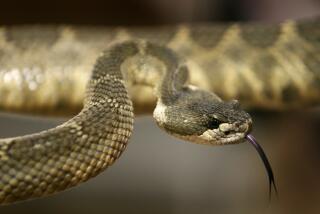Snakebite Victim in Stable Condition
- Share via
LANCASTER — The condition of a 64-year-old man who was bitten on the neck by a rattlesnake in his home Friday was upgraded to stable from critical Saturday.
Donald L. Mathews of Leona Valley was bitten by a 1 1/2-foot-long rattlesnake as he poked his head through a trapdoor in his attic.
Mathews’ injuries are no longer considered life-threatening, an Antelope Valley Hospital spokeswoman said.
Indoor snake encounters are extremely rare.
The last known incident in the area was two years ago, when a 20-month-old girl was bitten on the thumb by a baby diamondback rattlesnake that crawled into the family’s home through the door of an attached garage. The girl picked it up and showed her mother, who knocked it out of her hands.
The 18-inch snake was captured and the girl survived.
Mathews has received 37 anti-venom shots, but doctors fear the venom is continuing to spread, his wife said Saturday.
“He is frustrated,” said Betty Mathews. “He just wants to get out of the hospital.”
Mathews is still not able to speak, but has been writing notes or signaling with his hands to communicate.
She added that she has not investigated the attic to try to determine how the snake got in.
“I’ve lived here 19 years and I’m not afraid of anything in the house,” she said. “But I’m not going up there.”
Snakebites of any kind “aren’t all that common,” said Capt. Ron Hamilton of the Los Angeles County Fire Department. And, most snakebites occur on the legs, feet, arms and hands.
Hamilton said Mathews reacted the best possible way to being bitten--he kept calm, which kept the snake’s venom from spreading rapidly, and called the 911 emergency number.
“The best thing we can do is get them relaxed and to a hospital for anti-venom” serum, he said.
*
California’s only venomous snakes, rattlers begin a brief hibernation in late November and come out as early as February, authorities said. They are found mostly in deserts and foothills.
Mathews lives in a mountainous area just west of Palmdale.
Hamilton said his Antelope Valley station gets a snakebite call about once a year. “Over the years, we’ve killed more snakes than treated snakebites.”
He added that firefighters usually try to capture the reptile and set it free in the desert, but sometimes they are forced to destroy the snake if lives are threatened, Hamilton said.
“It is one of those things you just don’t want to take a chance about,” said Hamilton. “Snakes are serious. They will try to bite you, as Mr. Mathews found out.”
More to Read
Sign up for Essential California
The most important California stories and recommendations in your inbox every morning.
You may occasionally receive promotional content from the Los Angeles Times.













